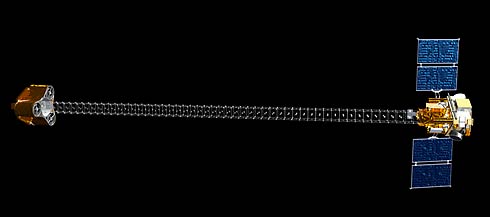UC Berkeley Press Release
 A 10-meter mast separates NuSTAR's three hard X-ray telescopes (left) from the imaging camera (right). The telescope will be built by Caltech and UC Berkeley scientists, launched in 2011 and operated from UC Berkeley mission control. (Caltech graphic) |
NASA resurrects NuSTAR mission to image massive black holes
BERKELEY – NASA announced today (Friday, Sept. 21) its intent to restart a small scientific satellite mission it had canceled in 2006 because of funding pressures created in part by the shift in the agency's focus to manned missions to the moon and Mars.
Now scheduled for launch in 2011, the Nuclear Spectroscopic Telescope Array (NuSTAR) mission consists of an X-ray telescope that focuses high-energy X-rays - called "hard" X-rays - to image the environments of massive black holes at the cores of galaxies. It will be the first focusing hard X-ray telescope in orbit, and will complement the soft X-ray observations of the orbiting Chandra X-ray observatory, which was launched in 1999.
"This instrument opens up a whole new waveband of the electromagnetic spectrum for astronomical observation, and potentially whole new areas of astrophysics," said Steven E. Boggs, a collaborator for the mission and an associate professor of physics at UC Berkeley. "X-ray telescopes such as Chandra have given us a glimpse of what's going on in black holes, but they also tell us that most of the action may be going on at higher energies. NuSTAR will survey black holes in a higher-energy waveband that lets us see where this action is happening."
NuSTAR will be led by principal investigator Fiona Harrison, professor of physics and astronomy at the California Institute of Technology, with critical pieces of the telescope built at UC Berkeley's Space Sciences Laboratory (SSL). UC Berkeley will also serve as mission control from its operations center in the hills behind the campus.
"It's great that NASA was able to restart the mission," Harrison said. "I'm personally incredibly excited about our planned science program, as well as the unanticipated things we are bound to discover with a new telescope this sensitive."
"We are very excited to be able to restart the NuSTAR mission," said Alan Stern, associate administrator for the Science Mission Directorate at NASA headquarters in Washington, D.C. "NuSTAR has more than 500 times the sensitivity of previous instruments that detect black holes. It's a great opportunity for us to explore an important astronomical frontier. We are getting more and more from the science budget we have, and the restart of the highly valued NuSTAR mission is an example of that."
Boggs noted that after the cancellation of the NuSTAR mission last year, "the astronomical community was very upset. To bring a mission along that far and then to pull the rug out from under it - many in the astrophysics community were appalled." NuSTAR had been one of six proposals selected in 2003 from 36 submitted to NASA's Explorer Program, which funds lower cost, highly focused, rapid-development scientific spacecraft, and had been meeting its milestones for an anticipated 2007 launch.
With the arrival of Stern this spring, small explorer missions, called SMEX, were back on the table. NASA will invite proposals by January for three new SMEX missions. NuSTAR's resurrection is a bonus, Boggs said.
"This is a very good sign that NASA and Alan Stern are committed to continuing NASA's tradition of performing cutting edge science," he said.
The active nuclei of galaxies are thought to harbor black holes with masses equivalent to millions or billions of suns, Boggs said. As this material swirls into the black hole, it is heated and emits X-rays. By looking at the soft X-ray band, up to 8,000 electron volts (8 keV), Chandra has revealed the roiling environment around these black holes. But much of the energy emitted by black holes is absorbed by the enshrouding gas and dust itself. This matter is more transparent to higher energies, however, which means NuSTAR, observing energies between 8 and 80 keV, can peer deeper into the maelstrom, closer to the event horizon behind which all matter disappears.
Because many black holes may be detectable only in hard X-rays, NuSTAR is expected to find many more as it surveys the sky.
Boggs said that this is the first satellite to use a new generation of focusing mirrors that operates at hard X-ray energies. Space Sciences Laboratory scientists are collaborating with Caltech in the design and fabrication of the focal plane instruments. SSL's highly automated mission control center, which currently operates satellites such as THEMIS (Time History of Events and Macroscale Interactions during Substorms), RHESSI (Reuven Ramaty High-Energy Solar Spectroscopic Imager) and FAST (Fast Auroral SnapshoT), will operate NuSTAR as well.
Links:

